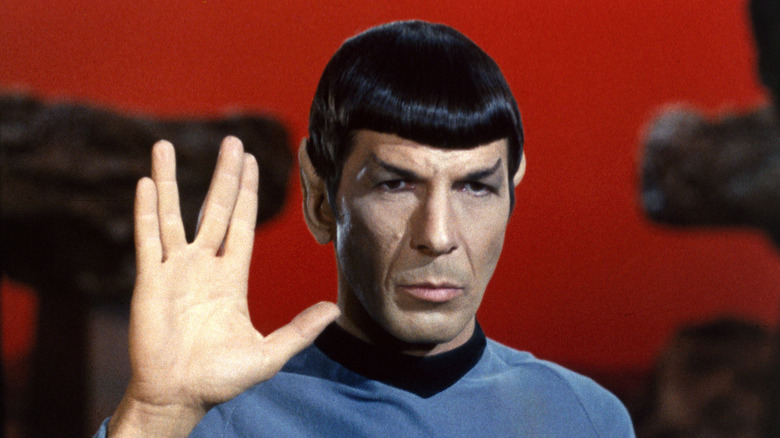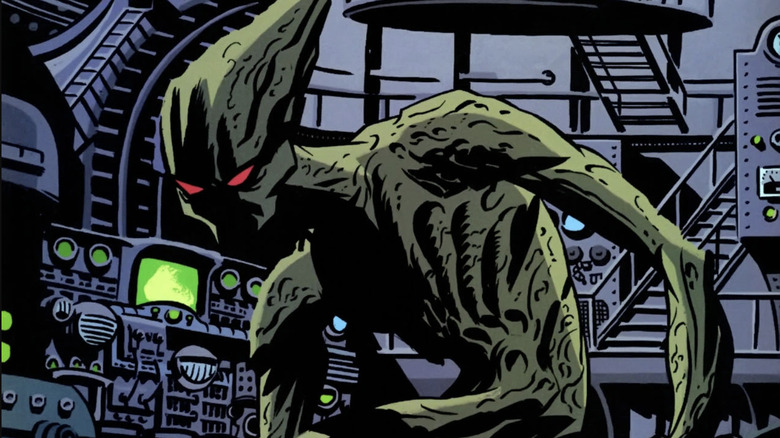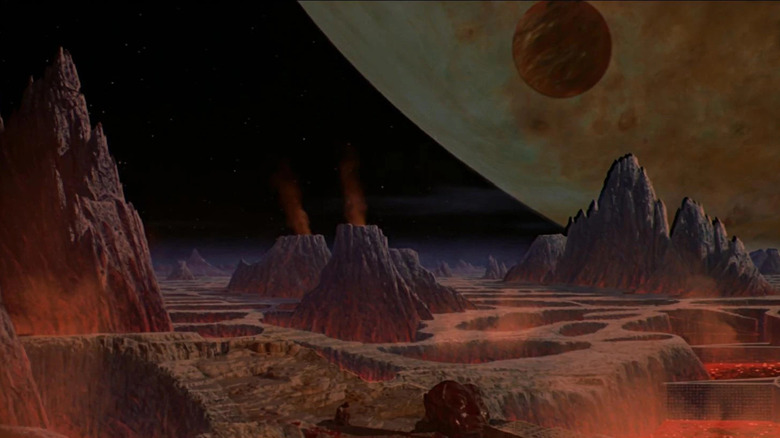Gene Roddenberry's Original Star Trek Pitch Gave Spock A Familiar Home Planet
The Vulcans are the most famous aliens in all of "Star Trek," surpassing even the Klingons and their martial cousins the Romulans. This all goes back to Spock (Leonard Nimoy), the co-star of the original "Star Trek," the franchise's first alien lead and arguably the defining character of the entire decades-long run on "Star Trek."
Though Spock is half-human by birth, he embraced his logical Vulcan side first and had the appearance to match. Spock, and the other Vulcans, showed how where no man has gone before, all someone needs to pass as an "alien" is a little bit of make-up on an otherwise human face. (In Vulcans' case, it's pointed, elvish ears.)
Spock's home planet is also named Vulcan after its people. For a long while, it was understood to be a fictional version of a real planet — HD 26965 b — orbiting the real star we call 40 Eridani A. But NASA recently revealed a devastating truth about the "real" Vulcan: this "planet" was nothing more than an illusion created by astronomical equipment.
If Spock's original backstory had been used, we wouldn't have this problem. You see, in "Star Trek" creator Gene Roddenberry's original 1964 pitch document ("Star Trek Is..."), Spock was described as "half-Martian." To give you a sense of just how much things changed: in this outline, the series' starship is also called the Yorktown, not the Enterprise.
Spock of Star Trek was originally conceived as a Martian
Spock was evidently one of the earliest "Star Trek" characters who Roddenberry conceived of. Of the characters in the pitch document's main cast list, only Spock made it to the final version of "Star Trek." Captain Robert April evolved into Christopher Pike, who became James T. Kirk (even though official "Trek" canon has rectified all three into separate characters). Meanwhile, Dr. Philip Boyce, the middle-aged cynic of the Yorktown, was evidently the basis of Dr. McCoy. The ship's female XO Number One appeared in the first rejected pilot, "The Cage," but was written out afterward.
Spock/Nimoy was also the only cast member to be brought over from "The Cage" to the replacement pilot, "Where No Man Has Gone Before." But while he had the same name all the way through development, other details of the character are quite different. In addition to being from Mars, the Spock in Roddenberry's original pitch is described as having red skin, with which his pointed ears make him look devilish, as well as a "curiosity about all things alien." (It's generally accepted that when Number One was discarded, Roddenberry shifted her emotionless personality and second-in-command role onto Spock.)
Mars being home to alien life was a common idea in early science-fiction. Most famously, there was Edgar Rice Burroughs' "A Princess of Mars" and its sequels. These were pulp stories about a human Civil War veteran named John Carter exploring the red planet. Mars' inhabitants, ranging from red-skinned humans to enormous, multi-limbed green aliens, call their home world "Barsoom." Likewise, DC Comics superhero J'onn J'onzz/The Martian Manhunter is a premier member of the Justice League. He's sometimes depicted as the last survivor of Mars like Superman, sometimes not.
Roddenberry was also a close friend of science-fiction writer Ray Bradbury, whose book "The Martian Chronicles," followed humans colonizing Mars and coming into conflict with indigenous Martians. The book's themes of interstellar cultural mingling definitely feel like an ancestor to "Star Trek."
Why Gene Roddenberry moved Star Trek's Spock from Mars to Vulcan
Why did Roddenberry choose to make Spock a Vulcan instead of a Martian? According to "Star Trek Creator: The Authorized Biography of Gene Roddenberry" by David Alexander, he thought that humans might go to Mars within his lifetime, and obviously there would be no pointy-eared aliens waiting for them. Hence, Vulcan, a fictional world (seemingly) unaffected by real discoveries. Spock's origins as a Martian do show in Vulcan's onscreen depiction, though. The planet is a desert world that looks rusty brown-colored from orbit, akin to Mars' reputation as "the red planet." Even the planet's name follows the same convention as Mars; all the planets in our solar system (Earth excluded) are named after Roman gods or titans. Mars is named for the god of war, and Vulcan for the god of fire and the forge. (The Greeks called these deities Ares and Hephaestus.)
Roddenberry's prediction that people would soon be walking on Mars was obviously way too optimistic, if not downright naive. We still haven't gotten there today. However, NASA did land the Viking 1 and Viking 2 probes on Mars in 1976. These and later probes have found that not only is there no humanoid life on Mars, but also that the planet can't sustain any.
As a result, the way Mars is portrayed in science-fiction has changed. It's more common to see it depicted as a terraformed colony of spacefaring humans (including in "Star Trek" itself), rather than a world home to an indigenous people. The whole concept of Martians is regarded as a science-fiction throwback that's associated more with pulpy 20th century sci-fi than its modern descendants. So, really, Roddenberry's thinking about making Spock a Vulcan was on the right track.


